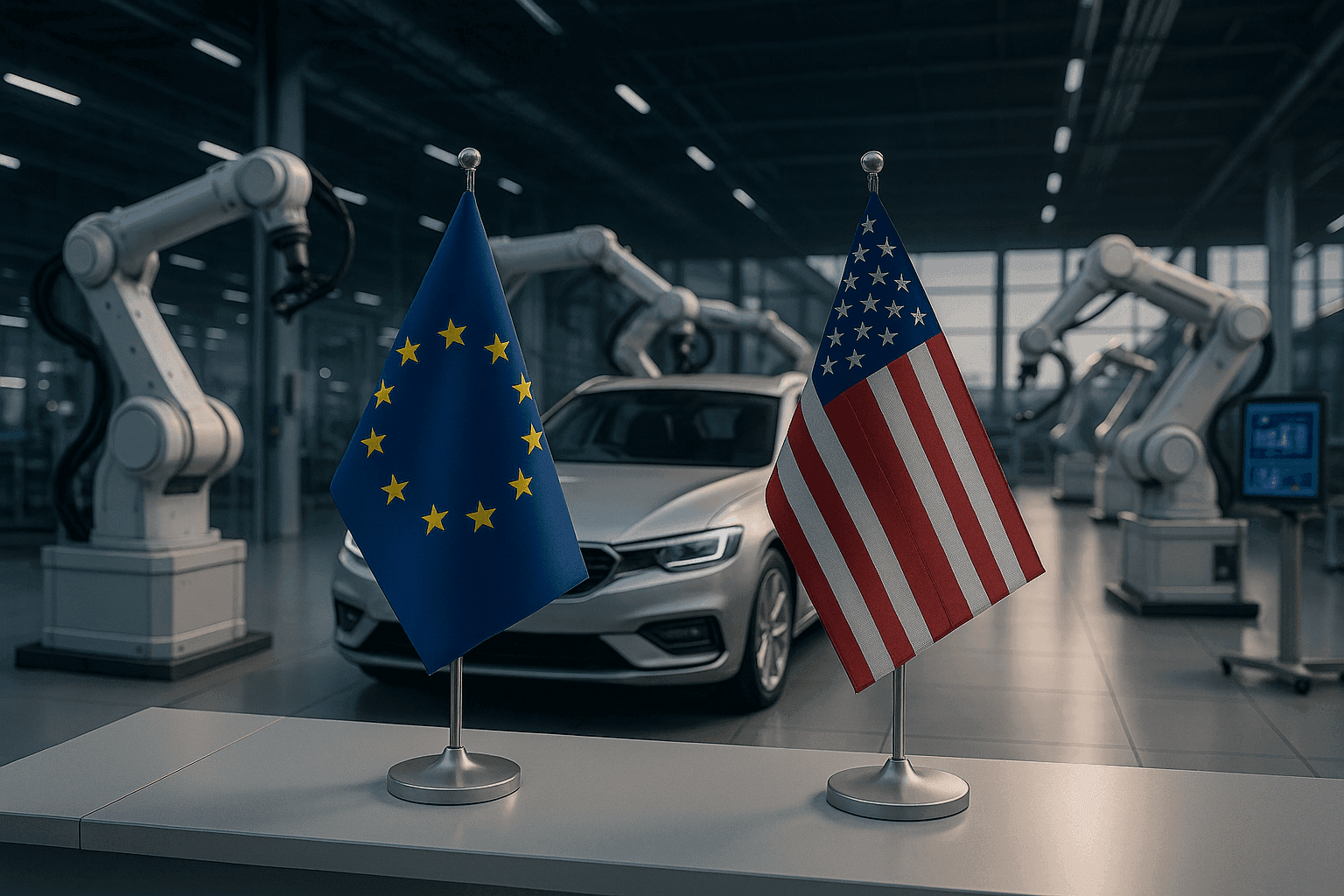Transatlantic Trade Deal: What the New 15% Tariff Means for Europe’s Premium Carmakers
The new 15% tariff on EU car exports may ease immediate tensions, but it locks in a structural cost burden. For premium OEMs and their suppliers, the pressure to localize and adapt is now a strategic imperative.
- Home /
- EU-US Tariff Deal: What Companies Need to Prepare for Starting Today /
- Automotive: Navigating the 15% Reality
15% Is Not Relief. It’s a New Strategic Reality.
On Sunday, 27 July 2025, the United States and the European Union reached a long-anticipated trade agreement, bringing a measure of stability to transatlantic economic relations. The centrepiece of the deal is a new 15% tariff on European car exports to the US, down from the previously imposed 25%.
While the headline suggests relief for European manufacturers, a closer look reveals a more complex picture: a short-term reprieve, yes, but one that prompts long-term strategic reconsideration for the automotive sector.
Behind the scenes, frustration is mounting. Many in the industry view the deal not as a breakthrough, but as a concession that cements a lasting cost disadvantage.
Several dynamics stand out:
- A 15% tariff still adds thousands in cost per vehicle. It’s a blow to premium OEMs that rely heavily on exports.
- US carmakers face little in return, with most EU tariffs remaining below 5%.
- German brands investing at home are penalised, while US-localised production is rewarded.
Audi, Porsche, and others face pressure to relocate or risk losing competitiveness.
In the end, this agreement wasn’t struck because it was fair. It was struck to avoid further escalation.
What Does the 15% Tariff Really Mean for Premium OEMs?
For premium carmakers such as BMW, Mercedes-Benz, and Audi, the reduction in tariffs marks a welcome easing of cost pressure, especially given that the US remains a key export market. BMW alone shipped over 60,000 vehicles from Germany to the US in 2024.
Still, 15% is not a minor surcharge. For high-end vehicles priced above $70,000, a 15% import duty means more than $10,000 in added cost. That significantly narrows the pricing gap with US-based competitors and diminishes the allure of German engineering, at least from a cost perspective.
In effect, the new rate softens the blow but institutionalises a new cost reality. European OEMs will need to plan for this financially, operationally and strategically.
Who Stands to Benefit?
European manufacturers with established production footprints in the US are clearly in a better position. BMW’s Spartanburg plant in South Carolina is a prime example. As one of the largest vehicle plants in the world, it allows BMW to build SUVs directly for the North American market, shielding them from the impact of tariffs.
Other brands such as Mercedes and Volkswagen also operate US-based manufacturing hubs. For these companies, little changes. If anything, they may gain a competitive edge, as rivals dependent on exports from Europe will need to adjust prices or absorb costs.
For manufacturers without a US production footprint, the message is clear: local presence is no longer optional. It is becoming a strategic necessity. We anticipate growing interest in greenfield investments, joint ventures, and contract manufacturing across the US and Mexico.
The Pressure on Suppliers
The implications of the new deal go far beyond OEMs. Tier-1 and Tier-2 suppliers across Europe, particularly in the DACH region, now face hard questions:
- Can we remain cost-competitive while exporting from Europe under a 15% tariff regime?
- Should we consider setting up manufacturing in North America?
How will shifting OEM footprints affect our contracts and logistics?
The operational model that prioritised centralised, high-efficiency European production is coming under pressure. For mid-sized suppliers, this could mean transformative decisions about their international setup. While relocation is capital-intensive and operationally complex, maintaining the status quo could risk being locked out of lucrative North American contracts.
Consumers and Market Structure
From a US consumer’s perspective, the new tariff structure could lead to moderate price reductions. Vehicles such as the Audi Q5 or the Mercedes E-Class may become more accessible, despite still bearing a 15% duty. A 10% tariff reduction on a €70,000 vehicle equates to a potential price drop of over $7,000.
However, the real-world impact will vary. Dealers may choose to retain part of that pricing flexibility to rebuild margins lost over recent years. Meanwhile, US brands will likely respond with competitive price adjustments of their own, maintaining pressure across the segment.
An Asymmetric Agreement?
Many in the European business community are already describing the deal as “uneven”. While EU car exports to the US will be taxed at 15%, US vehicle exports to the EU will mostly remain subject to tariffs well below 5%, or none at all.
From a trade policy standpoint, this raises eyebrows. The agreement appears more political than reciprocal, serving primarily to calm markets and avoid escalation. Strategically, it signals the EU’s willingness to compromise for the sake of stability, but it also cements a competitive disadvantage in one of its core industries.
The H&Z View: A Wake-Up Call for the Automotive Sector
At H&Z, we’ve worked for over two decades with leading players across the automotive value chain, from global OEMs to specialised suppliers. From our vantage point, the 15% tariff deal is not a catastrophe, but it is a strategic wake-up call.
We see three key developments taking shape:
- Production footprint optimisation becomes essential. US-based capacity is no longer just about market access; it is about mitigating systemic trade risk.
- Supply Chain Diversification moves from theory to necessity. Geopolitical resilience is now a boardroom priority, not just a procurement concern.
- Pricing Strategy Reassessment is urgent. Margins, incentives, and brand positioning must all be rethought in light of the new cost baseline.
What Comes Next?
The automotive industry is navigating a geopolitical realignment. This trade agreement is just one more tile in a larger mosaic that includes shifting global alliances, decarbonisation pressures, and digital transformation.
For decision-makers, this means re-evaluating strategies on multiple levels:
- Where are we most vulnerable in terms of margin erosion?
- Is our operating model flexible enough to adapt to political shocks?
What strategic options do we have beyond Europe?
The answers to these questions will shape market positions for years to come.
At H&Z, we work closely with our clients to tackle precisely these kinds of structural challenges, bridging market dynamics with operational reality. The 15% tariff is not a showstopper, but it is a moment of clarity.
For those who are willing to rethink, reposition, and re-invest, the opportunity is clear: safeguard competitiveness and shape the industry’s next chapter on both sides of the Atlantic.

